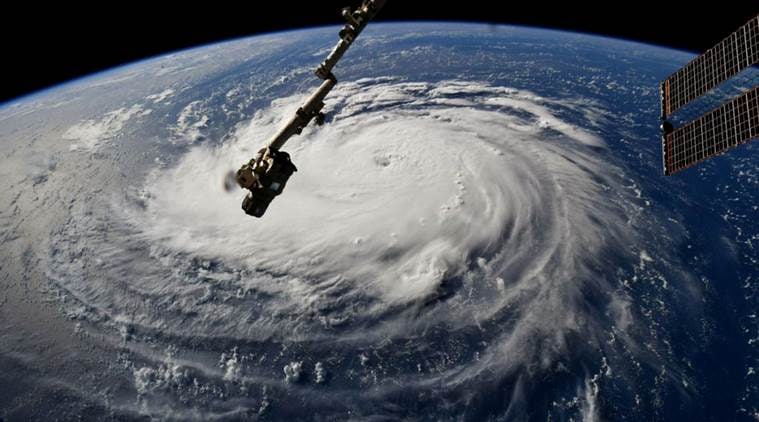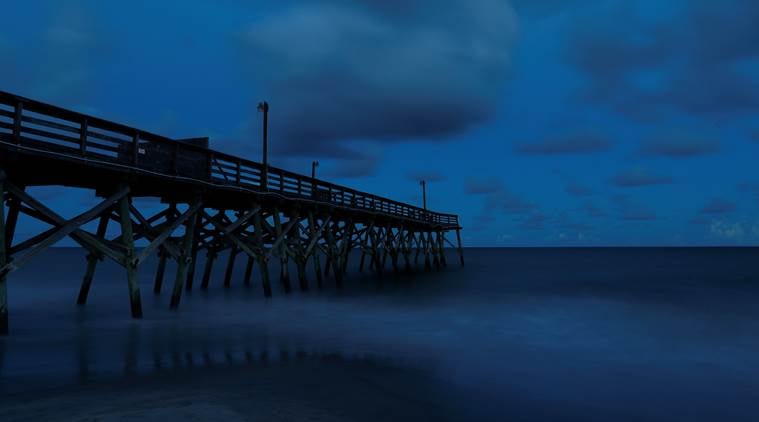 Hurricane Florence LIVE updates: Hurricane Florence is seen from the International Space Station as it churns in the Atlantic Ocean towards the east coast of the United States, September 10, 2018
Hurricane Florence LIVE updates: Hurricane Florence is seen from the International Space Station as it churns in the Atlantic Ocean towards the east coast of the United States, September 10, 2018
Hurricane Florence, on track to become the first Category 4 storm to make a direct hit on North Carolina in six decades, moved closer to its target and is expected to hit the shore by Thursday. Although Florence is yet to make a landfall, more than 1 million residents have been ordered to evacuate from coastal areas of North and South Carolina and Virginia.
Fierce winds and massive waves are expected to lash the coasts of the three states, and its rains will take a heavy toll for miles inland, the National Hurricane Center in Miami warned. Packing maximum sustained winds of 140 miles per hour (225 km per hour), the storm ranked as a Category 4 on the five-step Saffir-Simpson hurricane scale and was expected to grow stronger and larger over the next few days, the NHC said. “This storm is a monster,” North Carolina Governor Roy Cooper said. “Even if you’ve ridden out storms before, this one is different. Don’t bet your life on riding out a monster.”
 The Surfside Beach Pier which still shows some of the damage from 2016 during Hurricane Matthew is pictured ahead of Hurricane Florence in Surfside Beach, South Carolina, US. Reuters
The Surfside Beach Pier which still shows some of the damage from 2016 during Hurricane Matthew is pictured ahead of Hurricane Florence in Surfside Beach, South Carolina, US. Reuters
More than a million people in parts of South Carolina, North Carolina and Virginia have been ordered to immediately evacuate. University campuses, schools and factories are being shuttered. To hasten evacuations from coastal South Carolina, officials reversed the flow of traffic on some highways so all major roads led away from shore.
However, a lot of people have refused to leave and are instead preparing themselves before the storm lashes the states. Residents prepared by boarding up their homes and stocking up on food, water and other essentials, stripping grocery store shelves of merchandise. Many gasoline stations were running low on fuel.
People weren't the only ones evacuating to get out of the path of Hurricane Florence. Eight dogs and 18 cats from a shelter in Norfolk, Virginia, were sent to two shelters in Washington to make room for pets expected to be displaced by the hurricane.
The Navy is moving people and ships ahead of Hurricane Florence , and the Air Force and Army are both flying advanced aircraft elsewhere as a safeguard. Some remaining Marines, meanwhile, are digging in their heels.
While thousands of Marines and their families have already left Camp Lejeune in Jacksonville, North Carolina, the commanding general said Tuesday that anyone remaining at the base would have food, water and protection despite being in the projected path of the storm. ``Since 1941, this base and its Marines have been postured to deal with crises at home and abroad and Hurricane Florence is no exception,'' said a message from Brig. Gen. Julian D. Alford. Some military families and others took to Camp Lejeune's Facebook page, venting fears and questioning why there was no mandatory evacuation.
In Virginia, Navy officials on Tuesday issued an emergency evacuation order for active duty and civilian personnel, their families and reservists living in certain coastal areas for which the state had also ordered an evacuation. The move came after the Navy began sending dozens of its Virginia-based ships out to sea a day earlier. According to the Navy, the final two ships _ the hospital ship USNS Comfort and the aircraft carrier USS Abraham Lincoln _ sailed out of Naval Station Norfolk on Tuesday. More than 30 ships have now moved to safer waters in the Atlantic Ocean.
The U.S. Air Force and the Air National Guard also moved jets from Virginia's coast to Ohio. Officials from Joint Base Langley-Eustis in Hampton said the base's F-22 Raptors and T-38 Talon training jets would begin flying out Tuesday for Rickenbacker Air National Guard Base in central Ohio. (AP)
Florence's projected path includes half a dozen nuclear power plants, pits holding coal-ash and other industrial waste, and numerous hog farms that store animal waste in huge lagoons. Forecasters said parts of North Carolina could get 20 inches (50 centimeters) of rain, if not more, with as much as 10 inches (25 centimeters) elsewhere in the state and in Virginia, parts of Maryland and Washington, D.C.
In a public advisory, National Hurricane Centre has declared Hurricane Florence as 'extremely dangerous' and expected to bring 'life-threatening storm surge and rainfall' to portions of Carolinas and Mid-Atlantic states. It also said the storm is currently located about 670 mi (1075 km) east-southeast of cape fear North Carolina maximum sustained winds 140 mph (220 km/h)
A lot of experts have called the storm "big and monstrous." North Carolina's governor issued what he called a first-of-its-kind mandatory evacuation order for North Carolina's fragile barrier islands from one end of the coast to the other. Typically, local governments in North Carolina make the call on evacuations. ``We've seen nor'easters and we've seen hurricanes before,'' Cooper said, ``but this one is different.'' It has ticked all the right checkboxes that have got the experts worried, reported AP.
* Warmer than normal sea temperatures to add energy and rain to a storm. Check.
* A wind pattern that allows a storm to get strong and stay strong. Check.
* Higher sea levels to make a storm surge worse. Check.
* A storm covering enormous area, to drench and lash more people. Check.
* And an unusual combination of other weather systems that are likely to stall Florence when it hits the Carolinas, allowing it to sit for days and dump huge amounts of rain. Check.
Maps of Florence's trajectory showed the center of the storm most likely to strike the southern coast of North Carolina. The last Category 4 hurricane to plow directly into North Carolina was Hazel in 1954, a devastating storm that killed 19 people and destroyed some 15,000 homes. But NHC spokesman Dennis Feltgen stressed the effects of Florence would be widely felt. Tropical storm-force winds would extend nearly 300 miles across three states. A hurricane warning was posted for most of the Carolina coast north to the Virginia border.
North Carolina Gov. Roy Cooper warned the people, saying, "This storm is a monster. It's big and it's vicious. It is an extremely, dangerous, life-threatening, historic hurricane."Appealing to the people to take the warning seriously, he said, "The waves and the wind this storm may bring is nothing like you've ever seen. Even if you've ridden out storms before, this one is different. Don't bet your life on riding out a monster.''
Powerful Hurricane Florence is expected to bring days of rain, deadly flooding and power outages lasting weeks after it slams into the US Southeast coast later this week, news agency Reuters reported. Winds and massive waves will pound coastal North and South Carolina when Florence makes landfall on Friday, and its rains will take a heavy toll for miles inland, the National Hurricane Center (NHC) warned.
The National Oceanic and Atmospheric Administration's Weather Prediction Center forecasts as much as 20 inches (50 centimeters) of rain, if not more, for parts of North Carolina. Rain could reach as much as 10 inches (25 centimeters) elsewhere in North Carolina, Virginia, parts of Maryland and Washington, D.C.
US President Donald Trump said the safety of the American people is his 'absolute highest priority' as Hurricane Florence takes aim at portions of the East Coast.
Located about 750 miles (1,200 km) southeast of Bermuda, a Miami-based weather forecaster said Florence hurricane was packing maximum sustained winds of 75 miles per hour (120 km per hour). Here's all you need to know
Hurricane Florence could inflict the hardest hurricane punch North Carolina has seen in more than 60 years, with rain and wind of more than 130 mph (209 kph). North Carolina has been hit by only one other Category 4 storm since reliable record keeping began in the 1850s. That was Hurricane Hazel in 1954. Hurricane Hugo made landfall in South Carolina as a Category 4 hurricane in 1989.
According to the National Hurricane Center, Florence is getting better organised and increased in size. It is now about 845 MI (1360 km) East Southeast of cape fear North Carolina in the Atlantic with Maximum sustained winds of 130 MPH
Source: AP
A warm ocean gives hurricanes their fuel, and Florence is moving over an area with water temperatures nearing 85 degrees (30 Celsius), hurricane specialist Eric Blake wrote. With little wind shear to pull the storm apart, hurricane-strength winds have been expanding to 40 miles (64 kilometers) from the eye of the storm, and tropical-storm-force winds 150 miles from the center.
Hurricanes almost always set off an orchestrated dance on Wall Street before they make landfall, with shares of property and casualty insurance companies dumped in favour of companies that sell construction supplies or portable generators. Insurers, have built up war chests and insured their own potential losses given the severity of the storms that have been striking the coastal United States. North Carolina has the highest property and casualty insured premiums of the three states at $16 billion, followed by Virginia at $13.6 billion, and South Carolina at $9.5 billion, according to Citi.
The eye of the massive storm is forecast to make landfall late Thursday or early Friday along a stretch of coastline already saturated by rising seas, and then meander for days. Seven-day rainfall totals are forecast to reach 10 to 20 inches over much of North Carolina and Virginia, and even 30 inches in some places. President Trump said the federal government is "absolutely, totally prepared."